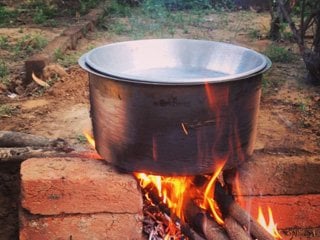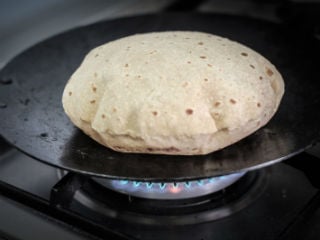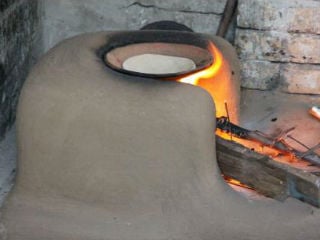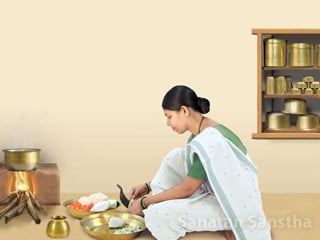Grains, pulses and vegetables have most important place in our kitchen. With their use; Sattvikta can be increased in our kitchen. We will learn some fundamental ingredients of food and cooking food from them. After understanding them and by putting them into practice, we will definitely be benefitted by their sattvikta
1. Grains
1. Grains contain 6 to 12% proteins, 1 to 5% fats and 60 to70% carbohydrates.
2. Though grains have lesser proteins than pulses, higher intake of grains in daily diet supplements necessary amount of proteins.
3. Generally, grains used for cooking are a year old. Grains that are less than a year old are difficult to digest. After three years, grains lose taste and hence, should be discarded.
A. Storing grains in large earthen jars underground
‘In the earlier times, the grains used to be stored underground in the godowns or large earthen jars. These godowns/jars were associated with Pruthvitattva because they were underground. As a result, the grains would get enriched with the Pruthvitattva. The human body is made up of Pruthvi and Apa and hence, food prepared from these grains was easier to digest and conducive to physical growth. These jars tapered at the top and as a result, a kind of sound would congregate in them. Due to this sound, the grains remained free from the influence of Raja-Tama resulting from contact with the ground. Thus, storing food-grains in these jars and using them later for cooking was very much a part of a good conduct.
B. ‘In the earlier times, grains used to be stored in a kanagi (A cornbin)
smeared with cow-dung, as a result of which the grains were protected from Raja-Tama waves.’
C. Method of preserving the stock of household grains from the spiritual perspective
1. Keep a sattvik Name-strip of any Deity near the stock of household grains ! : ‘Today, the extent of formation of distressing energy covering has increased everywhere. Therefore, it affects the food-grains in the house too. In order to avoid formation of such covering, keep a sattvik Name-strip of any Deity near the grain stock. The food-grain will imbibe Chaitanya from the Name strip and will benefit all those who eat the food prepared from these grains. Similarly, wave a sattvik incense-stick around the stock once a day.
2. Mix a pinch of Vibhuti obtained from burning incense stick in the grain stock.
3. During vastushuddhi (Spiritual purification of a premises), pray to Shrikrushna for creation of a protective sheath around the premises, the equipments in the house, foodstuff and water.’
D. Winnowing of grains
‘During winnowing, effort is made to congregate the Raja-Tama-predominant waves from the grains into the void-like space of a winnowing basket. Additionally, unwanted constituents are thrown out during this process. Raja-Tama-predominant waves from every substance kept in the sifting fan get attracted to the void of the sifting fan and congregate there, thereby purifying the grains subtly partially due to the contact with the air during the process of winnowing.
E. Washing, drying and grinding grains in a stone-grinder
Winnowing does not entirely purify the grains subtly; hence, earlier there was a practice of washing grains, drying them and then grinding them in a stone-grinder. When grains are washed with water, the Raja-Tama-predominant waves in them get transferred to water. Further, by drying them in sunlight, the remaining distressing vibrations get destroyed by the Tej in the sunlight. Such purified grains are then ground and charged with more pure and positive vibrations generated by the clockwise movements of the hands to produce the flour. The food prepared from grains thus processed is very sattvik. – H.H. [Mrs] Anjali Gadgil
F. Season favourable for sorghum and millet to be part of diet
1. Sorghum : Sorghum has a soothing effect on the body; hence, eat it during summers.
2. Millet : Millet has warming effect on the body; hence, eat it during winters.
G. Difference between the crops harvested in Bharat and overseas
‘Bharat is more Sattva-predominant than other countries.The sattvikta in the environment and the soil here makes the crops tastier.
| Crops harvested overseas | Crops harvested in Bharat | |
|---|---|---|
| 1. Method of farming | Scientific | Traditional |
| 2. Use of chemicals | Yes | No |
| 3. Sattva component | Less | More |
| 4. Sanskar created by the environment on the food | Tama-predominant | Raja-Sattva predominant |
| 5. Divine protection | Absent | Present |
| 6. Taste | Hardly any taste | Tasty |
2. Pulses and legumes
A. Pulses play an important role in rebuilding the wear and tear of the body.
B. Pulses contain 20 to 24 percent proteins, 1 to 5 percent fats and 55 to 60 percent carbohydrates.
C. Pulses of green gram and lentil are easy to digest and generate relatively less gas than other pulses.
D. Generally, pulses are devoid of essential amino acid ‘methionine’ (After digestion, proteins disintegrate into subtle amino acid particles); hence, pulses are used along with grains.
E. Another name for black gram is ‘mash’; meaning, equivalent to meat (in protein content). According to the science of Spirituality, eating meat increases the Tama component. However, black gram is considered equivalent to meat because of its high protein content and not from spiritual perspective. If a vegetarian individual becomes protein deficient, black gram or dishes prepared from black gram such as iḍli are an excellent supplement.
3. Vegetables
Benefits of including vegetables in meals
A. ‘Capacity of the body cells improves.
B. Physical strength and beauty increase.
C. Mind and intellect function systematically and adequately.
D. The sattvikta of an individual can increase by 5%, meaning, it can reach 30%.’
Reference : Sanatan’s granth, ‘Components required for cooking a meal‘

 Importance of metalware used for cooking and their benefits and harm
Importance of metalware used for cooking and their benefits and harm Types of fuels used for cooking and their beneficial as well as harmful effects
Types of fuels used for cooking and their beneficial as well as harmful effects What precautions should be taken while cooking ?
What precautions should be taken while cooking ? Benefits of cooking on a mud chulha
Benefits of cooking on a mud chulha How to maintain sattvikta in the kitchen ?
How to maintain sattvikta in the kitchen ? Benefits of cooking food on a low flame
Benefits of cooking food on a low flame